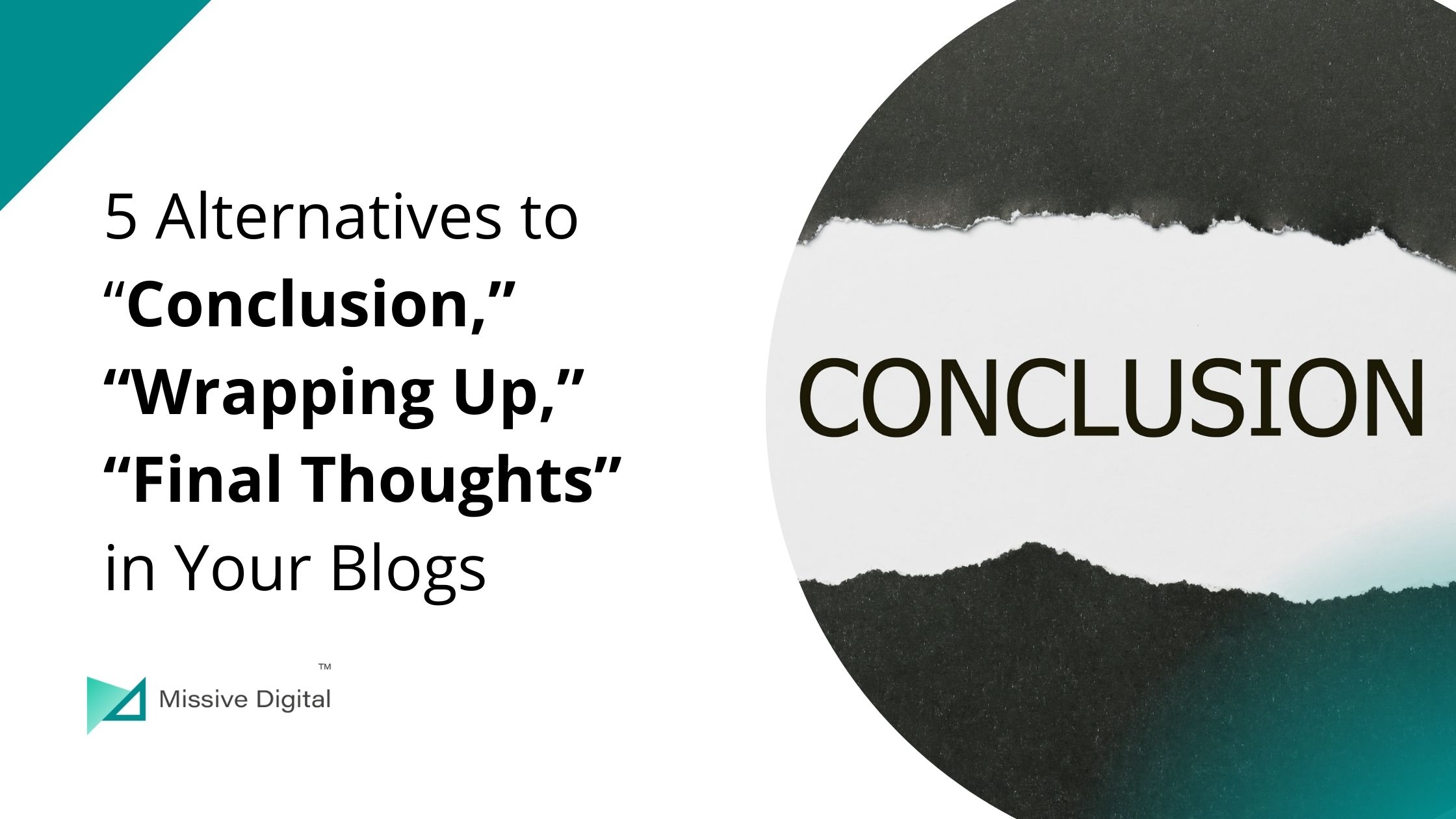How do you end your articles? Do you write “Conclusion,” “Wrapping Up,” or “Final Thoughts”?
Don’t worry, you’re not alone.
Most writers end their blogs with boring, typical headings because they don’t know any other way around it! But now we have the solution for you.
Because my Twitter Thread went viral, I thought to turn this into a blog to help writers, editors, and marketers to help their audience with some better headlines or headings (H2) when concluding their blogs.
WHY should we go beyond writing these typical conclusion headings?
When you end your blogs in a typical and traditional way, your blogs miss an opportunity to make a lasting impression and convert potential customers.
You should make your last H2 (heading tag) of the blog intent-specific, keyword-focused, and decision-driven for your audience and search engines to make your blog drive results.
You’ll get to know how in the rest of the blog.
While I’m writing this, here is the type of comment we place for our writers when they come to us for review and we find they have written such typical concluding headings.
So let me elaborate more on the thread and make writers’, marketers’, and search engines’ lives easy.
Five Creative Alternatives to Address “Conclusion” as the Headings
1. Encourage your audience to take Action:
One of the most impactful ways to end your blog is by encouraging your audience to take action.
Say, for example, your blog is talking about a range of products; you can ask them to comment on their favorite products, make a purchase with us, or share the blog with like-minded people.
Here is a blog that we wrote for London’s largest bespoke cake shop, Anges de Sucre, on “Is it cool to order a Doughnut Birthday Cake?” and our conclusion heading was- “Birthday Doughnut Cakes Are Better With Anges De Sucre”
Ensure your conclusion heading signifies what the body text is all about. If the body text is interesting enough but not reflected well in the final heading, it will lose its worth and charm.
Our team wrote a blog discussing effective enterprise UX design strategies for the UK-based IT services company Innovify, and here’s how we ended it!
As we provided information on multiple aspects of the enterprise UX, the concluding paragraph acts as a call-to-action (CTA) and inspires readers to implement given strategies for their competitive advantage.
Not just for the blogs that we write, but even for the blogs we optimize, we recommend changing the last concluding heading and making it inspiring enough to be action-driven.
Even, Aleyda Solis, one of the most influential international SEOs, used this type of alternative to conclusion in their post on 8 SEO tools to get Google Search Console URL Inspection API insights, where she wrote, “Dig deeper into your Google coverage status.”
Another way to end your blog effectively is by urging readers to think in a different way.
For example, if you are discussing two sides of a coin or weighing the pros and cons of a product/service, it’s a good idea to ask your audience a thought-provoking question.
We wrote content on the Top 10 Discord Servers to join as a Developer for Codemonk.ai, one of the top talent platforms for developers, and we wanted to invoke the audience’s thinking process with this conclusion headline, “In the End: what Discord Server to choose?”
In another blog for the same company, we wrote on Top Agile Team Characteristics Essential For Your Team and the concluding headline is “Does your team have agile characteristics?”
Moreover, if you are writing thought leadership content for your industry, it’s highly recommended to end your blogs with thought-provoking questions that provide a fresh outlook and perspective.
In my blog on Search Engine Land’s SaaS SEO challenges, I tried to invoke a thought-process for SEOs working in the SaaS industry that SEO for SaaS has to be careful and strategic investment as for them, speedy growth in sales and revenue matters the most first and then everything else and SEO is a slow game but still it has the power to reduce the customer acquisition costs drastically.
Lidia Infante used this type of thought-provoking conclusion heading with her latest data study on How Plural Keywords Impact Search Intent For Ecommerce with Search Engine Journal, where she wrote, “What Does This Mean For Your Ecommerce SEO Strategy?”
In short, let your audience think over again and again on what you’ve described or shared in the blog using your last concluding headline.
3. Guide them with the next step:
Going further, if you are serious about taking your readers to the next stage of their customer journey, it’s a good idea to guide your readers to the next step of the process.
Let’s say you are writing a blog that’s part of a bigger picture; you can end your blog, leading to the next piece of the puzzle.
Let’s take a look at one of the blogs from our favourites, Keyword Insights, on content map. Here the concluding H2 says, “Now It’s Your Turn to Create a Content Map!.”
Our blog that talks about SaaS marketing costs, its concluding headline guides users to define their goals to get better clarity about how much they should spend on their marketing.
Another brilliant example here is from a blog on A guide to diagnosing common JavaScript SEO issues by Tory Gray, where she asked SEOs to make friends with JavaScript in her conclusive H2 tag.
One more way to conclude your blogs is by providing proof for your suggestions. Let’s say you have written a blog post talking about the benefits of having the right content marketing strategy in place; you can conclude your blog post with the concluding heading, “As organic content Experiences are on Rise, Invest in Content Marketing Today.”
Because we are yet to work on any data study, we don’t have our examples but let us share some examples of how we can have such proof-based conclusion headings:
-
- 90% of products failed, don’t let yours.
(When guiding to startups on products)
- 90% of products failed, don’t let yours.
-
- The average Amazon conversion rate is around 13%. Utilize it effectively! (Based on this study by Semrush)
-
- ChatGPT user sessions are down by 29%. Do you still use it?
(Based on this study by Spartoro)
- ChatGPT user sessions are down by 29%. Do you still use it?
-
- GA3 has gone; Get your alternative now!
(When guiding marketers to choose an alternative to GA3 as it’s gone)
- GA3 has gone; Get your alternative now!
When you support your statements with data and facts, you position yourself as an authentic and authoritative figure in your industry. This type of concluding heading is especially effective when you have written action-provoking blog posts.
5. Write a thought-provoking, fact-based one-liner statements:
Last but not least, you can conclude your blog post with thought-provoking or fact-based one-liners. By writing eye-catching concluding headings, you leave lasting impressions in your readers’ minds.
It doesn’t necessarily have to be fact-based always; it can also be a summary of the blog post in one line.
Our blog about creating an effective blog structure is a perfect example of including a one-liner in your blogs.
Another thought-provoking concluding headline I saw Antonio Gabrić writes in his blog on Zapier that talks about How to find unlinked mentions and turn them into backlinks. His one-liner H2 is actually a fact, a statement there for link-building specialists, “Claiming unlinked brand mentions is worth it.”
Such fact-based one liner concluding H2 tags leave a WOW feeling that gets you comments, such as, “What a line!” “That’s so true!,” and more.
Make your conclusion heading work for your audience and on search engines
Now you understood how to make impactful concluding headings on your blogs that will impress your users, but how will it work for the search engines?
Follow these guidelines:
-
- Ensure your last heading has H2 assigned.
-
- Use the primary keyword in your last H2 so that your H1 of the blog and last H2 stays focused on the topic, which helps search engines understands what this page is all about and once they understand that better, they can serve them well on the SERPs with better rankings.
Check any of the above suggestions, we have made sure the primary blog keyword for the respective blogs has been used in the last heading of the blog.
So you now know multiple alternatives to conclude your blogs in a creative way, we hope you will never end your blogs in a traditional, boring, and monotonous way.
We are excited to see you using the above-mentioned techniques in various contexts and level up the standard of your blogs. Feel free to explore our other blogs related to marketing and enhance your knowledge horizon


